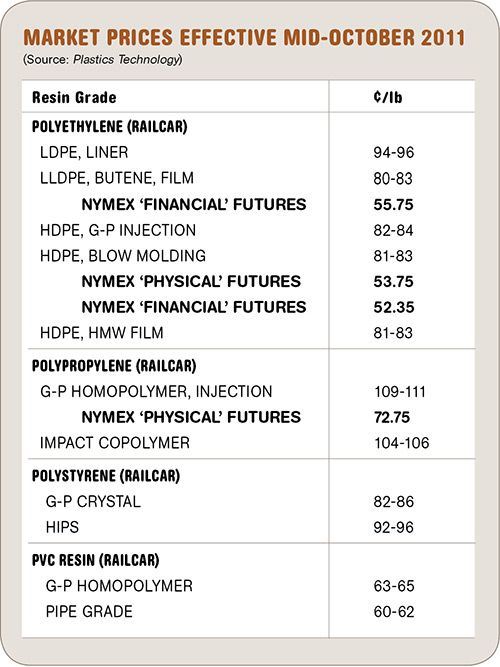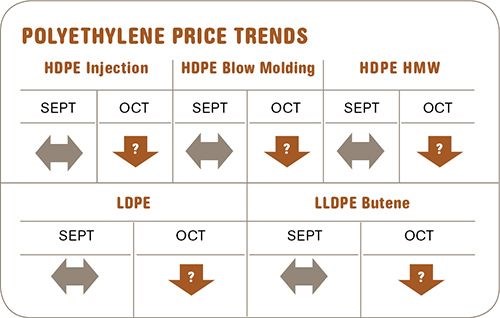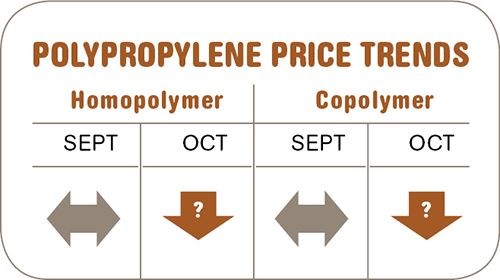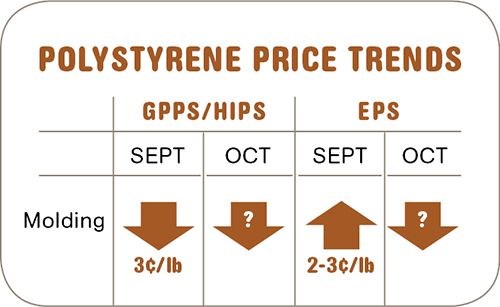Prices of Commodity Resins Are Lower and Headed Down
Prices of PE, PP, PS, and PVC were on the way down last month after remaining flat or slipping slightly in September.
Prices of PE, PP, PS, and PVC were on the way down last month after remaining flat or slipping slightly in September. Demand is dismal, except for PE, where the market is only lackluster. Moreover, downward pressure is coming from price erosion of key feedstocks and growing inventories at resin suppliers. Barring unexpected world events, this softer resin pricing trend is expected to continue for the remainder of the year, according to resin purchasing consultants at Resin Technology, Inc. (RTi), Fort Worth, Tex..
PE HIKES TABLED
Polyethylene prices remained flat through September, as suppliers failed to implement their 5¢ price hikes. Suppliers did not rescind any of their increases, which for October totaled 11¢/lb. Prices were not expected to increase, in any case.
Although demand for PE is slow but not bleak, it is no longer vibrant as was the case earlier in the year, and the outlook is for more of the same. Strong exports to Asia in July/August were halted by economic uncertainty; buyers retreated, leaving behind extra material with no place to go. Resin availability in the secondary market is quite good and pricing was flat but very little material was moving. Domestic production is down 5%, operating rates are down by 6%, though sales were
up by 3%.
Outlook & Suggested Action Strategies
30-60 Days: Buy as needed. December pricing is likely to be the market low.
PP DISCOUNTS SPREADING
Polypropylene prices remained flat in September, following the trend of propylene monomer contracts, which held at 78¢/lb. Propylene cracker turnarounds had no effect in tightening the market due to poor demand.
Despite PP suppliers throttling down production, supply remained quite ample. Resin plant operating rates dropped to the low 80s from the high 80s in August. Total sales were down by roughly 40 million lb and production was down by 130 million lb. Resin inventories actually shrank.
In the second half of September and through last month, spot PP prices were being discounted and propylene monomer prices were expected to settle lower. Despite more attractive secondary market prices, not much material was being moved. Many buyers have taken a more careful approach; uncertain demand and the potential for future price erosion is on everyone’s mind. The fourth quarter could end up being the slowest of the year.
Outlook & Suggested Action Strategies
30-60 Days: RTi anticipates October monomer contracts will drop as much as 10¢/lb. Buy as needed in anticipation of lower prices in October/November, with even lower prices next month.
PS PRICES DOWN, HEADED LOWER
Polystyrene prices dropped an average of 3¢/lb across the board by the end of September, and further price erosion was expected in October and over the rest of the year. Spot GPPS prices were up to 8¢ lower by last month.
Prices of key feedstocks (benzene, ethylene, and butadiene) declined significantly in the last couple of months, lowering the average cash cost to make GPPS by 5.5¢ and HIPS by 7.5¢/lb. As a result, the premium for HIPS has begun to narrow. Last month, it remained at 11¢ to 12¢/lb in North America, but was down 9-10¢ in Asia and Europe, driven by the large drop in butadiene prices. Having peaked at $2.20/lb, butadiene has been falling, with spot prices as low as $1.30/lb and September contracts settling downward at $1.70-1.75/lb. Styrene monomer spot prices dropped by as much as 7.5¢/lb by the end of September, and September contracts were 3¢ lower.
Outlook & Suggested Action Strategies
30-60 Days: Expect plenty of resin availability and prices to soften further. Suppliers will attempt to shed inventory in the face of lower demand. RTi suggests that HIPS buyers negotiate lower premiums over GPPS, which RTi expected to shrink by 3¢/lb in October.
PVC PRICES SLIDE
PVC prices dropped at least a penny across the board in September, and spot prices kept sinking through mid-October. PVC feedstock costs were 1¢/lb lower in September, and a slightly larger decrease was expected last month, based primarily on anticipated lower ethylene contact prices.
PVC domestic demand grew 12% in August due to restocking and to some improvement in construction. Exports grew 17% to a new record above 565 million lb, accounting for 43% of total demand. Then economic uncertainty here and abroad slowed everything down. The domestic demand outlook is for a continued slowdown, and ditto abroad, causing falling export prices.
Outlook & Suggested Action Strategies
30-60 Days: Buy as needed and look for lower prices. RTi expects softer global demand through the year’s end to help push PVC resin prices still lower.
Related Content
Improving Twin-Screw Compounding of Reinforced Polyolefins
Compounders face a number of processing challenges when incorporating a high loading of low-bulk-density mineral filler into polyolefins. Here are some possible solutions.
Read MoreCommodity Resin Prices Flat to Lower
Major price correction looms for PP, and lower prices are projected for PE, PS, PVC and PET.
Read MoreMelt Flow Rate Testing–Part 1
Though often criticized, MFR is a very good gauge of the relative average molecular weight of the polymer. Since molecular weight (MW) is the driving force behind performance in polymers, it turns out to be a very useful number.
Read MoreDensity & Molecular Weight in Polyethylene
This so-called 'commodity' material is actually quite complex, making selecting the right type a challenge.
Read MoreRead Next
Recycling Partners Collaborate to Eliminate Production Scrap Waste at NPE2024
A collaboration between show organizer PLASTICS, recycler CPR and size reduction experts WEIMA and Conair will seek to recover and recycle 100% of the parts produced at the show.
Read MoreFor PLASTICS' CEO Seaholm, NPE to Shine Light on Sustainability Successes
With advocacy, communication and sustainability as three main pillars, Seaholm leads a trade association to NPE that ‘is more active today than we have ever been.’
Read MorePeople 4.0 – How to Get Buy-In from Your Staff for Industry 4.0 Systems
Implementing a production monitoring system as the foundation of a ‘smart factory’ is about integrating people with new technology as much as it is about integrating machines and computers. Here are tips from a company that has gone through the process.
Read More














 (2).jpg;maxWidth=300;quality=90)
















